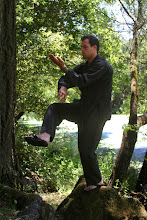WingChun with Abijah
Tenets of Wing Chun include practicality, efficiency and economy of movement. Practitioners are encouraged to sense the energy behind their movements. The core philosophy becomes a useful guide to practitioners when modifying or refining the art.
Wing Chun believes in using the least amount of required force in any fighting situation. It believes properly timed positioning and movements can and should be used to defeat an opponent. This is achieved through balance, body structure and relaxation.
Wing Chun uses deflection and counter-attack in the same motion or will intercept the opponent to nullify an attack, rather than blocking then attacking in two separate motions. This means that the opponent's attack is automatically deflected by the arm-structure of the Wing Chun practitioner as the counter-punch is delivered.The "structure" permitting this deflection to occur is controlled through the correct focus of energy from the "core" to the "elbow".
Notice the Key word here "Core", this is a new concept in western fitness but has been the main focus for physical fitness for thousands of years. The development of intuitive awareness of body is an art form, a practice. Wing Chun Kung-fu is one of the many traditional Chinese art forms used to develop this intuitive awareness of body thereby harmonizing the relation of body & mind. The byproduct of studying this art form is the ability to defend yourself in threatening situations.
For me Wing chun has been a physical confirmation to what has been revealed in zazen meditation. Wing chun is moving from the center, and after having realized this has been an amazing teacher of The Way. I would like to reveal some of the deeper insight that I have been so fortunate to see through the practice and contemplation of Wing chun. Over the next few weeks I will be posting these insights every other day or so, I hope you enjoy.

No comments:
Post a Comment